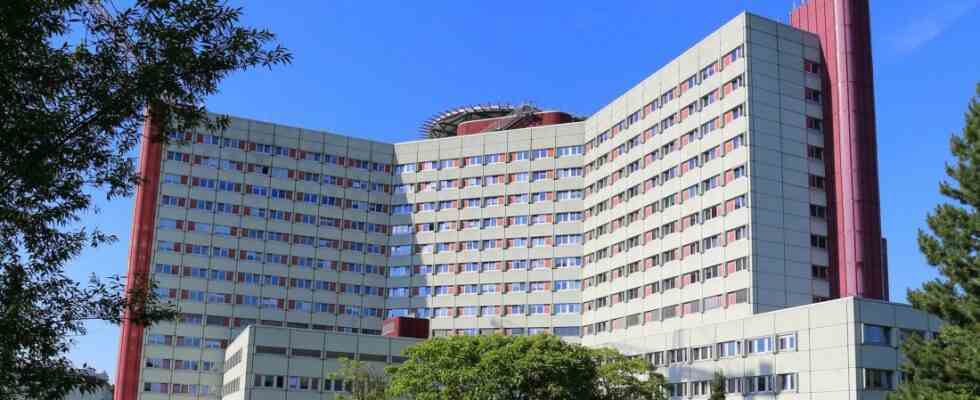If you talk to Michael Beyer about the general renovation of the University Hospital in Augsburg, the medical director quickly speaks of “a mammoth task”. This is because, according to his calculations, the renovation of the main building with the four bed towers could take up to 20 years and cost 1.5 billion euros. But it is also because, according to Beyer, the corona pandemic has left “a field of rubble”. Due to the shortage of nursing staff, among other things, the university clinic will no longer be able to operate up to 250 beds and numerous operating rooms. Other hospitals in the region are doing the same. “We have to restructure the entire situation in the health sector,” says Beyer.
While voices are being raised in Augsburg that want to consider a new building instead of a general renovation in order to save costs and nerves for patients and employees, Beyer has initiated a process with all the surrounding hospitals. At the end of the year, this should result in an overall concept for medical care in Swabia. This is how Beyer imagines a division of tasks between hospitals in the region. “The university clinic does not have to operate on every appendix, we have to take care of the serious cases. But we have to organize a sensible division of labor.” Ideally, not only hospitals from Nördlingen to Allgäu should be included in the overall concept, medical care centers and family doctor’s practices should also be considered in order to take account of the shortage of doctors in the country. “The time has come to enter into dialogue. We can no longer let things continue as before,” says Beyer.
With around 250,000 patients per year and more than 1,700 beds, the Augsburg hospital is one of the largest in Germany. The emergency room is even the second largest in Germany. Became a university hospital in 2019, the maximum care provider comprises 23 clinics and three institutes, in which 6,500 employees work. Extensive renovations have already been carried out on the 40-year-old building in recent years, as have new buildings, such as a children’s clinic. A request from the Augsburg SPD member of the state parliament, Simone Strohmayr, revealed that the electricity supply and the drinking water and sewage network must first be renewed in two years. According to the Ministry of Science, the actual general renovation is therefore not planned until 2027 at the earliest.
“In view of the long construction route and the costs, one should reconsider whether a new building would not be more suitable,” says Strohmayr. “This must not only be discussed at the administrative level, but also in the state parliament.” In this way, sanitation costs could possibly be saved, but in any case patients and staff could be spared. Medical director Beyer describes this as a “political decision and question of costs”. Previous considerations envisage taking one of the four bed towers completely out of operation, gutting them and rebuilding them one after the other. This requires interim buildings for clinic operations and administration, which could possibly be an expansion stage for a new building. “One would have to discuss whether that makes sense,” says Beyer.
“Every house can no longer offer the complete bouquet.”
Before that, however, an overall concept with the hospitals in the region is needed. Because such a coordination process with the other clinics in the region could also have consequences for the renovation plans. “It may be that we then have to rethink the general renovation and the existing structure with our bed towers and the functional units,” says Beyer. Obstetrics, for example, is “a very difficult topic” that requires coordination. In the emergency room and intensive care, too, one must see how medical care in the various hospitals will be restructured in the future. “The willingness to find a solution is there,” says Beyer.
Martin Gösele sees it that way too. “Every house can no longer offer the complete bouquet of flowers,” says the board of directors of the Wertach clinics in Bobingen and Schwabmünchen in the south of Augsburg. In this respect, he welcomes Beyer’s initiative. “The university clinic is the biggest player in Swabia, it’s a quality that the vote is being sought there.” He, too, feels the shortage of nursing staff, he too has to contend with bottlenecks and a significant increase in absenteeism. “In this respect, it makes sense to cooperate even more closely.”
However, Gösele reminds that his hospitals have already worked closely with the university clinic, for example in stroke care, in oncology, and also in trauma care. “We have to see what we can do and what cases are for a maximum care provider.” The Wertach clinics have been going “the path of specialization” for a long time. The houses in Bobingen and Schwabmünchen do not serve urological diseases at all, for other interventions such as gallbladder operations, Gösele sees his house as well positioned as a specialist clinic. The specialization ensures medical quality for patients and brings financial advantages to the hospitals.
Actually, states member of parliament Strohmayr, the Free State should start with the hospital planning. Instead, Michael Beyer next wants to hold a regional conference with medical providers from northern Swabia, Donauwörth, Wertingen, Dillingen and Nördlingen. “The talks are just beginning,” says the medical director of the University Hospital in Augsburg. He does not see a comparably comprehensive project for the restructuring of regional medical care across Bavaria.

